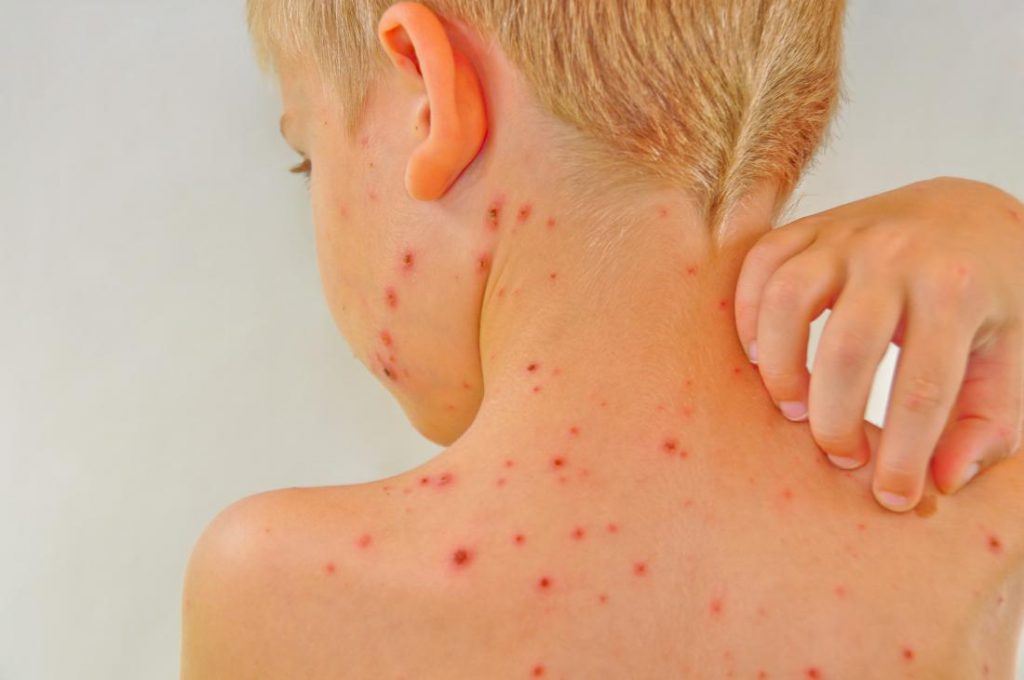Home > Healthcare >

Home > Healthcare >
This post is also available in: Tiếng Việt (Vietnamese)

Authors:
The weather is in transition and chickenpox is growing strongly. According to the Department of Preventive Medicine (Ministry of Health), chickenpox is an acute infectious disease caused by the Varicella Zoster Herpes virus.
The disease occurs at all ages and is highly contagious. Adults are less susceptible to the disease than children, but the disease in adults is often worse.
When a chickenpox carrier says, sneezes or coughs… the viruses follow the saliva, the nose falls and dissolves in the dust. Others inhale these dust particles to spread the disease immediately.
In addition, the virus is able to live for a few days in chickenpox when it comes off, and exists in the air, so it can also be transmitted through secretions of chickenpox burns.
On the other hand, the disease can also spread through indirect contact with living things and tools infected with a virus. Another pathway passes from the mother to the fetus through the placenta or birth.
A healthy person after about 10 to 14 days of exposure to the disease will likely show signs of mild fever, fatigue and anorexia. Then, the appearance of erythema nodules, after a few hours, appears bullas on the skin of the head and face; then spread throughout the body.
Inside, the bulla contains a clear liquid; if infected, they will become larger and contain a milky liquid. The infected person may have only a few chicken pox nodules on more than 500 nodules on the body.
The disease will last 7 to 10 days if there is no complication, the chickenpox nodules will dry out, flake off, the skin deep where the vesicles do not leave scars, but if they are infected with more of bacteria, leave scars.
Itchy rashes can be the first sign of illness and allow people to be easily confused with another disease. The patient is able to transmit it to others about 5 days before the first appearance of a bulla until it is completely dry.
The disease can also lead to dangerous complications such as meningitis, hemorrhage, sepsis, chickenpox infection, cellulitis, hepatitis… Some cases can be fatal if the patient is not treated quickly.
Varicella pneumonia is less common, but it is very serious and very difficult to treat. The encephalitis caused by chickenpox also occurs, but rarely: after chickenpox, children suddenly become distressed, excited, sometimes accompanied by seizures, coma.
These cases may have long-term neurological sequelae: deafness, developmental delay, convulsions… The mother has chicken pox during pregnancy and may have a child with birth defects.
The treatment of chickenpox is primarily an antiviral, an infection prevention and a supportive general medicine aimed at helping the disease recover more quickly and cause the least possible complications. The disease should be screened early, properly treated, promptly, cleaned and applied properly to minimize the risk of severe scarring.
The chickenpox vaccine is extremely effective and long lasting. It helps the body to create antibodies against the chicken pox virus, which is applied to the following topics: 1 single injection for all children aged 12 to 18 months; 1 single injection in children aged 19 months to 13 years who have never had chickenpox; should be administered twice, 4 to 8 weeks apart, in children over 13 years of age and adults who have never had chickenpox.
If the chickenpox vaccine has been administered, the majority of the 80-90% benefit from absolute protection. However, the remaining 10% may have chicken pox after vaccination, but these cases are only mild, with very few nodules, less than 50 nodules and often uncomplicated.
If a person has not been vaccinated against chickenpox, but if she has been exposed to chickenpox patients for 3 days, the vaccine can be used to promote protection immediately afterwards to prevent chickenpox.
In addition, to prevent chickenpox, it is necessary to limit contact with patients, particularly pregnant women who are not immunized against chickenpox and who must avoid concentrating during the course of the disease.
To prevent illness in the community, patients must stop school, take time away from work about 7 days after the blisters have dried out; cover your mouth and nose when coughing or sneezing with a tissue or cloth, then discard or wash the towels; do you often wash your hands with soap and clean water after coughing or sneezing, before eating, preparing food and drinking; keep homes, schools and workplaces clear; disinfection of children’s toys, tools of life.
People must understand the dangers of chicken pox. Since then, each person knows how to protect themselves, their family members, and those around them.
Sources: